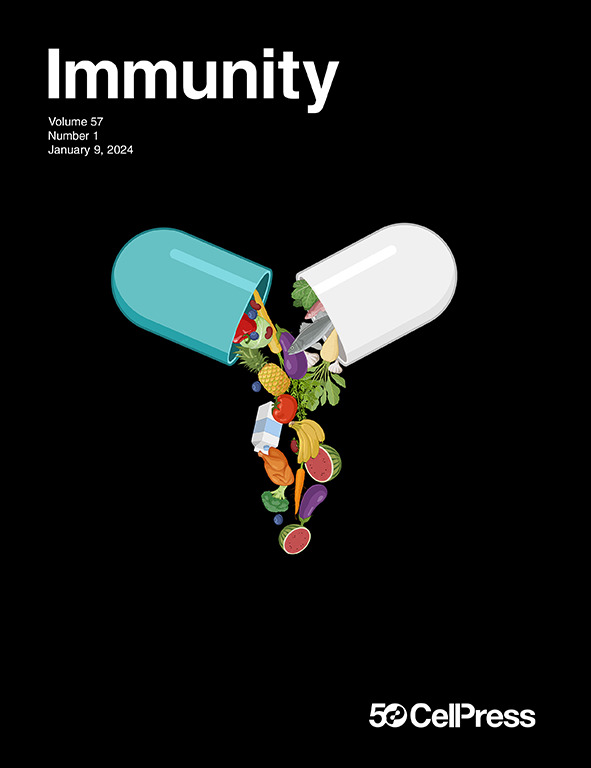增强子驱动的基因调控网络揭示了肿瘤微环境中控制T细胞适应和分化的转录因子
IF 26.3
1区 医学
Q1 IMMUNOLOGY
引用次数: 0
摘要
具有组织驻留记忆CD8+ T细胞(Trm)表型的肿瘤浸润淋巴细胞(til)与实体恶性肿瘤患者预后的改善有关。为了确定控制trm样TIL形成的程序,我们在感染和癌症模型中对T细胞受体(TCR)匹配的CD8+ T细胞进行了配对的单细胞RNA测序和单细胞ATAC测序。从多组学分析数据中组装的增强子驱动的调控揭示了与典型耗尽和记忆T细胞状态相关的调节trm样TIL形成的表观遗传和转录程序。转录调节因子KLF2抑制CD69+CD103+ trm样TIL的形成,抑制抗肿瘤活性。相反,转录因子BATF的持续表达增强了CD69+CD103+ TIL的形成,这取决于KLF2的下调。转化生长因子β (TGF-β)信号和CD103表达是trm样TIL形成的必要条件,但在tgfbr2沉默细胞中,BATF过表达足以驱动CD69+CD103+ TIL的形成。这些发现揭示了trm样TIL分化的机制,并为考虑肿瘤微环境中CD8+ T细胞异质性背景下的组织驻留提供了一个框架。本文章由计算机程序翻译,如有差异,请以英文原文为准。

Enhancer-driven gene regulatory networks reveal transcription factors governing T cell adaptation and differentiation in the tumor microenvironment
Tumor-infiltrating lymphocytes (TILs) with a tissue-resident memory CD8+ T cell (Trm) phenotype are associated with improved patient outcomes in solid malignancies. To define programs governing the formation of Trm-like TIL, we performed paired single-cell RNA sequencing and single-cell ATAC sequencing of T cell receptor (TCR)-matched CD8+ T cells in models of infection and cancer. Enhancer-driven regulons assembled from multiomic profiling data revealed epigenetic and transcriptional programs regulating the formation of Trm-like TIL in relation to canonical exhausted and memory T cell states. The transcriptional regulator KLF2 repressed the formation of CD69+CD103+ Trm-like TIL and limited anti-tumor activity. Conversely, sustained expression of the transcription factor BATF enhanced formation of CD69+CD103+ TIL, contingent upon downregulation of KLF2. Transforming growth factor β (TGF-β) signaling and CD103 expression were necessary for Trm-like TIL formation, but BATF overexpression was sufficient to drive formation of CD69+CD103+ TIL in TGFBR2-silenced cells. These findings reveal mechanisms of Trm-like TIL differentiation and provide a framework for considering tissue residency in the context of CD8+ T cell heterogeneity in the tumor microenvironment.
求助全文
通过发布文献求助,成功后即可免费获取论文全文。
去求助
来源期刊

Immunity
医学-免疫学
CiteScore
49.40
自引率
2.20%
发文量
205
审稿时长
6 months
期刊介绍:
Immunity is a publication that focuses on publishing significant advancements in research related to immunology. We encourage the submission of studies that offer groundbreaking immunological discoveries, whether at the molecular, cellular, or whole organism level. Topics of interest encompass a wide range, such as cancer, infectious diseases, neuroimmunology, autoimmune diseases, allergies, mucosal immunity, metabolic diseases, and homeostasis.
 求助内容:
求助内容: 应助结果提醒方式:
应助结果提醒方式:


